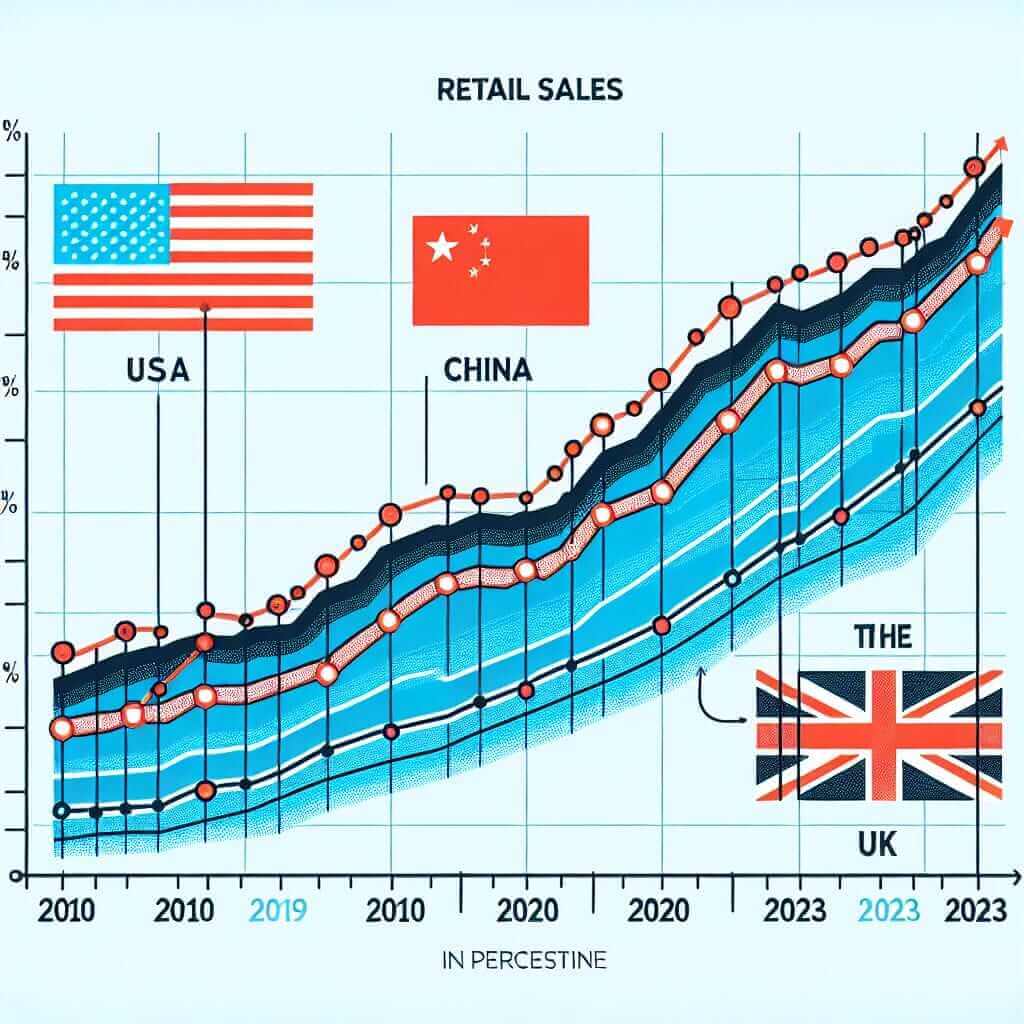The IELTS Writing Task 1 often presents data in various formats, requiring test-takers to analyze and summarize the information effectively. One common data type is the line graph, frequently used to illustrate trends over time. Understanding how to interpret and articulate these trends is crucial for achieving a high band score. This article will delve into the intricacies of describing “Retail Sales Growth in Different Countries (2010-2023),” providing you with the necessary tools and strategies to conquer this IELTS challenge.
Understanding the Task: Analyzing Retail Sales Trends
Before diving into data analysis, it’s vital to understand what the IELTS examiner expects. The task will likely present a line graph showcasing retail sales growth across several countries over a specific period, in this case, 2010 to 2023. Your objective is to:
- Identify key trends: Are sales generally increasing, decreasing, or fluctuating? Are there significant differences between countries?
- Highlight significant features: What are the highest and lowest points? Are there any periods of rapid growth or decline?
- Compare and contrast data: How do the trends in one country compare to others?
Sample Task: Visualizing the Data
Let’s assume the following line graph represents the retail sales growth (in percentage) of three countries – the USA, China, and the UK – from 2010 to 2023.
[Insert a line graph here with the x-axis representing the years 2010-2023 and the y-axis representing percentage growth in retail sales. Show three distinct lines representing the USA, China, and the UK. You can use any online tool to create a graph or simply describe the trends in words within the graph area. For example:
Line Graph: Retail Sales Growth in the USA, China, and the UK (2010-2023)
The graph shows an upward trend for all three countries, with China experiencing the most significant growth, followed by the USA and then the UK. There are some fluctuations, notably a dip in sales around 2020 for all countries.]

Dissecting the Data: A Step-by-Step Analysis
- Introduction: Begin by paraphrasing the task and stating the type of graph presented. For example:
“The line graph illustrates the percentage change in retail sales witnessed in the USA, China, and the UK over a 13-year period, from 2010 to 2023.”
- Overview: Provide a general overview of the main trends observed.
“Overall, all three countries experienced an upward trajectory in retail sales, although the rate of growth varied considerably.”
- Detail Analysis: Now, delve into specifics, comparing and contrasting the data.
“China demonstrated the most dramatic growth, with retail sales surging from approximately [mention starting percentage from the graph] in 2010 to a peak of [mention peak percentage from the graph] by [mention the year of peak sales from the graph]. In contrast, the UK experienced more moderate growth, starting at [mention starting percentage] and reaching [mention peak percentage] by 2023. The USA displayed a relatively steady increase, albeit with a slight dip around 2020, reflecting a potential impact of global economic factors.”
- Conclusion (Optional): You can choose to conclude by summarizing the key differences or highlighting a significant point.
“In conclusion, while all three nations experienced positive growth in retail sales, China emerged as the frontrunner, indicating its expanding consumer market.”
Writing Tips for Band 7+
- Paraphrasing is Key: Avoid directly copying words from the task. Use synonyms and rephrase information to demonstrate your vocabulary range.
- Cohesive Devices: Utilize linking words and phrases like “whereas,” “in contrast,” “similarly,” etc., to ensure a smooth flow and logical connections between sentences and paragraphs.
- Accurate Data Representation: Be precise when describing figures and trends. Use appropriate vocabulary to denote increases (rose, climbed, surged) and decreases (declined, dipped, plummeted).
- Grammar and Vocabulary: Employ a variety of grammatical structures and vocabulary related to trends, comparisons, and data interpretation.
Vocabulary Booster:
- Surge (v.): To increase suddenly and strongly (e.g., Sales surged in the second quarter.)
- Plummet (v.): To fall or drop straight down at high speed (e.g., Profits plummeted after the scandal.)
- Fluctuate (v.): To rise and fall irregularly in number or amount (e.g., Oil prices have been fluctuating wildly.)
- Trajectory (n.): The path followed by something (e.g., The company’s growth trajectory has been impressive.)
- Witness (v.): To show or demonstrate (e.g., The market witnessed a significant shift in consumer behavior.)
- Considerably (adv.): To a large or noticeable extent (e.g., The new model is considerably more expensive.)
- Moderate (adj.): Average in amount, intensity, quality, or degree (e.g., The company achieved moderate growth last year.)
- Albeit (conj.): Although (e.g., He accepted the job, albeit with some hesitation.)
- Dip (n.): A slight decrease in the amount of something (e.g., There was a slight dip in sales last month.)
- Frontrunner (n.): The person or organization that seems most likely to win a competition or achieve something (e.g., China is a frontrunner in renewable energy development.)
By mastering these strategies and expanding your vocabulary, you can confidently tackle any IELTS Writing Task 1 that involves analyzing retail sales trends or any other data presented in a line graph format. Remember, practice is crucial, so continue to analyze various graphs and write your own reports to hone your skills and achieve your desired band score.